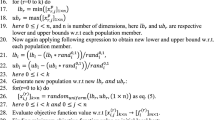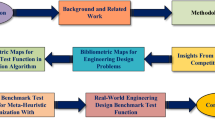Abstract
A novel Nash-EGO algorithm is presented to extend the usage of efficient global optimization (EGO) into large-scale optimizations by coupling with Nash game strategy. In our Nash-EGO, the large-scale design variables are split into several subsets by adopting Nash variable territory splitting, and the EGO optimizer acts as a player of specific Nash game. All the EGO players are coupled with each other and assigned to optimize their own subsets synchronously in parallel to produce the corresponding approximate optimal subsets. Doing in this way, the performance of EGO players could be expected to keep at a high level due to the fact that EGO players now take care of only their own small-scale subsets instead of facing the large-scale problem directly. A set of typical cases with a small number of variables are firstly selected to validate the performance of each EGO player mentioned. Then, the Nash-EGO proposed is tested by representative functions with a scale up to 30 design variables. Finally, more challenge cases with 90 design variables are constructed and investigated to mimic the real large-scale optimizations. It can be learned from the tests that, with respect to conventional EGO the present algorithm can always find near optimal solutions, which are more close to the theoretical values, and are achieved, moreover, less CPU time-consuming, up to hundreds times faster. All cases with 30 or 90 design variables have similar efficient performances, which indicates the present algorithm has the potential to cope with real large-scale optimizations.





Similar content being viewed by others
References
Jones, D.R., Schonlau, M., Welch, W.J.: Efficient global optimization of expensive black-box functions. J. Glob. Optim. 13(4), 455–492 (1998)
Forrester, A.I.J., Keane, A.J., Bressloff, N.W.: Design and analysis of “Noisy” computer experiments. AIAA J. 44(10), 2331–2339 (2006)
Li, C., Brezillon, J., Görtz, S.: Efficient global optimization of a natural laminar airfoil based on surrogate modeling. In: Dillmann, A., Heller, G., Krämer, E., Kreplin, H., Nitsche, W., Rist, U. (eds.) New Results in Numerical and Experimental Fluid Mechanics IX: Contributions to the 18th STAB/DGLR Symposium, pp. 53–63. Springer International Publishing, Cham (2014)
Durantin, C., Marzat, J., Balesdent, M.: Analysis of multi-objective Kriging-based methods for constrained global optimization. Comput. Optim. Appl. 63(3), 903–926 (2016)
Hamza, K., Shalaby, M.: A framework for parallelized efficient global optimization with application to vehicle crashworthiness optimization. Eng. Optim. 46(9), 1200–1221 (2014)
Keane, A.J.: Statistical improvement criteria for use in multiobjective design optimization. AIAA J. 44(4), 879–891 (2006)
Zhang, Q., Liu, W., Tsang, E., Virginas, B.: Expensive multiobjective optimization by MOEA/D with Gaussian process model. IEEE Trans. Evol. Comput. 14(3), 456–474 (2010)
Huang, D., Allen, T.T., Notz, W.I., Zeng, N.: Global optimization of stochastic black-box systems via sequential kriging meta-models. J. Glob. Optim. 34(3), 441–466 (2006)
Sóbester, A., Leary, S.J., Keane, A.J.: On the design of optimization strategies based on global response surface approximation models. J. Glob. Optim. 33(1), 31–59 (2005)
Ginsbourger, D., Le Riche, R., Carraro, L.: Kriging is well-suited to parallelize optimization. In: Tenne, Y., Goh, C.K. (eds.) Computational Intelligence in Expensive Optimization Problems. Adaptation Learning and Optimization, vol. 2, pp. 131–162. Springer, Heidelberg (2010)
Xu, S., Chen, H.: New type of multi-point updating strategy for EGO parallelization. Trans. NU-AA 30, 1–5 (2013)
Zhan, D., Qian, J., Cheng, Y.: Balancing global and local search in parallel efficient global optimization algorithms. J. Glob. Optim. 67(4), 873–892 (2017)
Jurecka, F.: Robust Design Optimization Based on Metamodeling Techniques. Shaker, Aachen (2007)
Deng, F.: Research on Efficient Global Optimization Algorithm and Its Application. Nanjing University of Aeronautics and Astronautics, Ph.D. thesis (2011)
Ur Rehman, S., Langelaar, M.: Efficient global robust optimization of unconstrained problems affected by parametric uncertainties. Struct. Multidiscip. Optim. 52(2), 319–336 (2015)
Jeong, S., Murayama, M., Yamamoto, K.: Efficient optimization design method using kriging model. J. Aircr. 42(2), 413–420 (2005)
Forrester, A.I.J., Bressloff, N.W., Keane, A.J.: Optimization using surrogate models and partially converged computational fluid dynamics simulations. In: Proceedings of The Royal Society of London A: Mathematical, Physical and Engineering Sciences, London, UK, pp. 2177–2204 (2006)
Deng, F., Qin, N., Liu, X., Yu, X., Zhao, N.: Shock control bump optimization for a low sweep supercritical wing. Sci. China Technol. Sci. 56(10), 2385–2390 (2013)
Jo, Y., Choi, S.: Variable-fidelity aerodynamic design using gradient-enhanced kriging surrogate model with regression. In: Proceedings of 52nd AIAA Aerospace Sciences Meeting, National Harbor, Maryland, AIAA 2014-900 (2014)
Gogulapati, A., Friedmann, P.P., Martins, J.R.R.A.: Optimization of flexible flapping-wing kinematics in hover. AIAA J. 52(10), 2342–2354 (2014)
Li, C., Brezillon, J., Görtz, S.: Efficient global optimization of a natural laminar airfoil based on surrogate modeling. In: Dillmann, A., Heller, G., Mer, E.K., Kreplin, H., Nitsche, W., Rist, U. (eds.) New Results in Numerical and Experimental Fluid Mechanics IX, Notes on Numerical Fluid Mechanics and Multidisciplinary Design, pp. 53–63. Springer International Publishing, Basel (2014)
Kanazaki, M., Matsuno, T., Maeda, K., Kawazoe, H.: Efficient global optimization applied to wind tunnel evaluation-based optimization for improvement of flow control by plasma actuators. Eng. Optim. 47(9), 1226–1242 (2015)
Namura, N., Shimoyama, K., Obayashi, S.: Kriging surrogate model enhanced by coordinate transformation of design space based on eigenvalue decomposition. In: Proceedings of the International Conference on Evolutionary Multi-Criterion Optimization, Guimarães, Portugal, pp. 321–335 (2015)
Endo, N., Kanazaki, M., Murayama, M., Yamamoto, K.: Influence of engine intake/exhaust on wing design of civil aircraft by means of knowledge discovery techniques. In: Proceedings of 54th AIAA Aerospace Sciences Meeting, San Diego, California, AIAA 2016-0772. (2016)
Othman, N., Kanazaki, M.: Trajectory and aerodynamic control optimization of civil aircraft descent under hazard situations based on high-fidelity aerodynamic database. In: Proceedings of 34th AIAA Applied Aerodynamics Conference, Washington, D.C, AIAA 2016-4041. (2016)
Kenway, G.K.W., Martins, J.R.R.A.: Multipoint aerodynamic shape optimization investigations of the common research model wing. AIAA J. 54(1), 113–128 (2016)
Oseledets, I.V., Tyrtyshnikov, E.E.: Breaking the curse of dimensionality, or how to use SVD in many dimensions. SIAM J. Sci. Comput. 31(5), 3744–3759 (2009)
Wang, G.G., Shan, S.: Review of metamodeling techniques in support of engineering design optimization. J. Mech. Des. 129(4), 370–380 (2007)
El Majd, B.A., Desideri, J., Habbal, A.: Aerodynamic and structural optimization of a business-jet wingshape by a Nash game and an adapted split of variables. Mécanique Ind 11(3–4), 209–214 (2010)
Périaux, J., Greiner, D.: Efficient parallel Nash genetic algorithm for solving inverse problems in structural engineering. In: Neittaanmäki, P., Repin, S., Tuovinen, T. (eds.) Mathematical Modeling and Optimization of Complex Structures, pp. 205–228. Springer International Publishing, Cham (2016)
Greiner, D., Periaux, J., Emperador, J.M., Galván, B., Winter, G.: Game theory based evolutionary algorithms: a review with Nash applications in structural engineering optimization problems. Arch. Comput. Methods Eng. 24(4), 703–750 (2017)
Krige, D.G.: A statistical approach to some basic mine valuation problems on the Witwatersrand. J. South. Afr Inst. Min. Metall. 52(6), 119–139 (1951)
Matheron, G.M.: Principles of geostatistics. Econ. Geol. 58(8), 1246–1266 (1963)
Sekishiro, M., Venter, G., Balabanov, V.: Combined kriging and gradient-based optimization method. In: Proceedings of the 11th AIAA/ISSMO Multidisciplinary Analysis and Optimization Conference, Portsmouth, Virginia, pp. 6–8 (2006)
Kenny, Q.Y., Li, W., Sudjianto, A.: Algorithmic construction of optimal symmetric Latin hypercube designs. J. Stat. Plan. Inference 90(1), 145–159 (2000)
Whitley, D.: A genetic algorithm tutorial. Stat. Comput. 4(2), 65–85 (1994)
Shan, S., Wang, G.G.: Survey of modeling and optimization strategies to solve high-dimensional design problems with computationally-expensive black-box functions. Struct. Multidiscip. Optim. 41(2), 219–241 (2010)
Rumpfkeil, M.P.: Optimizations under uncertainty using gradients, Hessians, and surrogate models. AIAA J. 51(2), 444–451 (2013)
Nash, J.: Non-cooperative games. Ann. Math. 54(2), 286–295 (1951)
Lee, D., Gonzalez, L.F., Periaux, J., Srinivas, K., Onate, E.: Hybrid-game strategies for multi-objective design optimization in engineering. Comput. Fluids 47(1), 189–204 (2011)
Anders O. Göran, Marcus M. Edvall.: User’s guide for TOMLAB/CGO1. https://tomopt.com/tomlab/download/manuals.php (2008). Accessed 7 Sep 2017
Suganthan, P.N., Hansen, N., Liang, J.J., Deb, K., Chen, Y., Auger, A., Tiwari, S.: Problem definitions and evaluation criteria for the CEC 2005 special session on real-parameter optimization KanGAL report. Technical report, Singapore (2005)
Liang, J.J., Qu, B.Y., Suganthan, P.N.: Problem definitions and evaluation criteria for the CEC 2014 special session and competition on single objective real-parameter numerical optimization. Technical report, Singapore (2013)
Sasena, M., Papalambros, P., Goovaerts, P.: Exploration of metamodeling sampling criteria for constrained global optimization. Eng. Optim. 34(3), 263–278 (2002)
Xiong, G., Shi, D., Duan, X.: Enhancing the performance of biogeography-based optimization using polyphyletic migration operator and orthogonal learning. Comput. Oper. Res. 41, 125–139 (2014)
Li, X., Yin, M.: Multi-operator based biogeography based optimization with mutation for global numerical optimization. Comput. Math. Appl. 64(9), 2833–2844 (2012)
Acknowledgements
This work was partially supported by the National Natural Science Foundation of China (Grant No. 11172134) and the Foundation of “Jiangsu Innovation Program for Graduate Education” (Grant No. KYLX_0218). We would like to thank the anonymous reviewers for their helpful comments.
Author information
Authors and Affiliations
Corresponding author
Appendices
Formulas of test functions in Sect. 3.1
(1) Branin function
where \(-5\le x_1 \le 10\), \(0\le x_2 \le 15\), its minimum is 0.3979.
(2) Hartman 3 function
where \(a_{ij} =\left[ {{\begin{array}{lll} 3 &{}1&{} {30} \\ {0.1}&{} {10}&{} {35} \\ 3&{} {10}&{} {30} \\ {0.1}&{} {10}&{} {35} \\ \end{array} }} \right] \), \(c_{ij} =\left[ {{\begin{array}{l} 1 \\ {1.2} \\ 3 \\ {3.2} \\ \end{array} }} \right] \), \(p_{ij} =\left[ {{\begin{array}{lll} {0.3689}&{} {0.117}&{} {0.2673} \\ {0.4699}&{} {0.4389}&{} {0.747} \\ {0.1091}&{} {0.8732}&{} {0.5547} \\ {0.03815}&{} {0.5743}&{} {0.8828} \\ \end{array} }} \right] \), \(0\le x_i \le 1\), \(i=1, 2, 3\), its minimum is \(-3.8628\).
(3) Hartman 6 function
where \(a_{ij} =\left[ {\begin{array}{llllll} {10}&{} 3&{} {17} &{}{3.5}&{} {1.7}&{} 8 \\ {0.05}&{} {10}&{} {17} &{} {0.1}&{} 8&{} {14} \\ 3&{} {3.5}&{} {1.7} &{} {10}&{} {17}&{} 8 \\ {17}&{} 8&{} {0.05} &{} 0&{} {0.}&{} {14} \\ \end{array} } \right] \), \(c_{ij} =\left[ {{\begin{array}{l} 1 \\ {1.2} \\ 3 \\ {3.2} \\ \end{array} }} \right] \), \(0\le x_i \le 1\), \(i=1,2,\ldots ,6\),
\(p_{ij} =\left[ {{\begin{array}{llllll} {0.1312}&{} {0.1696}&{} {0.5569} &{} {0.0124}&{} {0.8283}&{} {0.5886} \\ {0.2329}&{} {0.4135}&{} {0.8307} &{} {0.3736}&{} {0.1004}&{} {0.9991} \\ {0.2348}&{} {0.1451}&{} {0.3522} &{} {0.2883}&{} {0.3047}&{} {0.6650} \\ {0.4047}&{} {0.8828}&{} {0.8732} &{} {0.5743}&{} {0.1091}&{} {0.0381} \\ \end{array} }} \right] ,\) its minimum is \(-3.3224\).
Formulas of test functions in Sect. 3.2
(1) Sphere function
where D is the number of variables, \(-100\le x_i \le 100\), its minimum is 0.
(2) Elliptic function
where D is the number of variables, \(-10\le x_i \le 10\), its minimum is 0.
(3) Ackley function
where D is the number of variables, \(-32\le x_i \le 32\), its minimum is 0.
(4) Rastrigin function
where D is the number of variables, \(-5.12\le x_i \le 5.12\), its minimum is 0.
(5) Shifted and rotated Ackley function
where \(\mathbf{z}=\mathbf{M}({\mathbf{x-o}})\), \(\mathbf{z}=({z_1 , z_2 , \ldots , z_D })\), \(x=({x_1 , x_2 , \ldots , x_D })\), D is the number of variables, \(\mathbf{M}\) is the linear transformation matrix, and \(\mathbf{o}\) is the shifted global optimum, their values can be refer to Ref. [42, 43]. \(-32\le x_i \le 32\), its minimum is \(f_{bias} \), in this paper, it is set as \(f_{bias} =-140\).
Rights and permissions
About this article
Cite this article
Xu, S., Chen, H. Nash game based efficient global optimization for large-scale design problems. J Glob Optim 71, 361–381 (2018). https://doi.org/10.1007/s10898-018-0608-3
Received:
Accepted:
Published:
Issue Date:
DOI: https://doi.org/10.1007/s10898-018-0608-3




